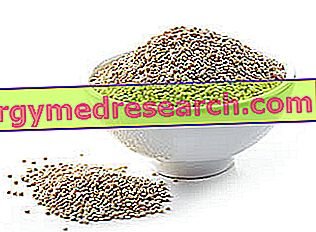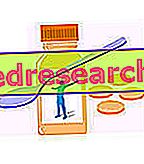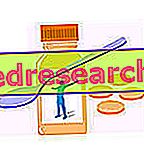Generality
Pinworms, also known as children's worms, are a type of intestinal worms responsible for a parasitosis known as oxyuriasis or enterobiasis .
Scientifically known as Enterobius vermicularis, pinworms are helminths Nematodes of cylindrical and elongated shape, and whitish in color.

The most common symptom of pinworm infestation is anal and perianal itching.
For an accurate diagnosis of oxyuriasis, observation of the faeces and the anal area and the execution of a scotch test are essential.
Today's therapy is pharmacological and consists of oral administration of drugs, such as mebendazole, albendazole and pyrantel pamoate.
Short reference to helminths
Visible to the naked eye at the adult stage, helminths are worm-like multicellular parasites, which live inside the host organism (usually in the intestine), at the expense of the latter.
The parasitosis typically remains at levels of severity such as to keep the host alive, since his death would also compromise the survival of the parasites.
The typical consequences of helminth infestations (or parasitosis ) are: debilitation of general health, presence of diseases and / or state of malnutrition.
According to the most traditional of classifications, in nature there would be three main groups of helminths:
- The group of Platelminti or flatworms, which can be subdivided into Cestodi and Trematodi .
- The group of nematodes or cylindrical worms .
- The group of Acanthocephalic or hooked worms .
What are pinworms?
Pinworms are Helminths Nematodes, known in the scientific field with the words of Enterobius vermicularis .
These small cylindrical worms cause a helminthiasis (ie a helminth parasitosis ) known as oxyuriasis or enterobiasis .
Pinworms are a classic example of intestinal worms, or vermiform parasites that infest the intestine and cause, very often, gastro-intestinal disorders.
Features
Despite their small size, adult pinworms are visible to the naked eye in the form of small white filaments.
Adult females are between 8 and 13 millimeters long, and have a diameter of about 0.5 millimeters, while adult males are between 2 and 5 millimeters long and have a diameter of about 0.15 millimeters.

Epidemiology
Pinworm infestation is widespread throughout the world and is the most common type of helminthiasis in countries such as the United States, the United Kingdom, Italy, Denmark, Sweden, etc.
According to a US study, conducted by the Center of Disease Control ( Center of Disease Control ), oxyuriasis would have an incidence rate, on the general population, of 11.4%.
Pinworm infestation can affect anyone; however, it is particularly evident among children, particularly among children living in crowded environments, in large school communities and / or in poor hygiene conditions.
Oxyositis does not present any predilection for men or women (therefore it affects the two sexes equally) and is not particularly associated with a race, a social class or precise cultural practices; among helminthiasis, it represents an exception to the rule that intestinal parasites would be the prerogative of poor communities and an uncommon problem in rich communities.
| Table. Prevalence rates of oxyuriasis in children, related to some countries of the world. | |
| country | Prevalence rate |
| India | 61% |
| England | 50% |
| Thailand | 39% |
| Sweden | 37% |
| Denmark | 29% |
Synonymous with pinworms
Due to their marked tendency to affect children, pinworms are also known as " children's worms ".
Causes
In most cases, human beings contract pinworm infestation by ingestion of embryonated eggs, which can reach the mouth through food or hands that have previously come into contact with the hands of contaminated people, with contaminated items, contaminated sheets and so on.
In this regard, scientific studies have shown that, on the hands of human beings, pinworm eggs can survive for several hours, while on contaminated objects, if the environment is optimal, they can survive even for 3 weeks.
In addition to the ingestion of embryonated eggs, another possible and not negligible mode of transmission of pinworms is the inhalation of the embryonated eggs.
Curiosity: what is the ideal environment for pinworm eggs?
For the survival of pinworm eggs on objects etc., the moist environment is the optimal condition.
Excessive heat and cold, on the other hand, are poorly tolerated: in the first case, maximum survival is a couple of days, while, in the second case, it is just over 18 hours.
Life cycle
The life cycle of pinworms begins with the event of ingestion of their eggs by the future host organism.
After their ingestion, the eggs begin to tread the digestive tract until they reach the small intestine, where they hatch and give life to the larvae . In the small intestine and in the contiguous zones, the larvae of the pinworms find the nourishment that serves them to develop, grow and advance to the large intestine ( cecum, appendix and colon); here, they definitely become adult worms.
Female pinworms survive in the colon and in nearby sites from 5 to 13 weeks; instead, pinworms for about 7 weeks.
In the period of stay in the large intestine, the males fertilize the females, in order to produce a new progeny (ie new eggs).
After fertilization, the male specimens rapidly undergo lysis (due to some intestinal enzymes) or are eliminated with feces; the female specimens, instead, adhere to the intestinal mucosa and grab part of the food that reaches the large intestine (NB: it is the food ingested by the host organism), in order to nourish and mature the eggs generated by fertilization.
Consider that an oxide female can contain 11, 000 to 16, 000 eggs.
Once the egg ripening process is complete, the female pinworms disintegrate (ie break off) from the intestinal wall and move in the direction of the anal opening, due to the deposition of the aforementioned eggs in the skin folds present outside the anus; after the laying, the females die in less than half an hour and the eggs take from 4 to 6 hours, to become infectious-weeds (NB: in optimal conditions).
Below are some interesting facts that further enrich the scenario described above:
- Female pinworms may begin to lay new eggs 5 weeks after ingestion of the first eggs by the host organism.
- The females emerge from the anus, due to the deposition of the eggs, because, for this process, they need the oxygen that they can obtain only outside the human intestine.
- Unlike the eggs of many other helminth parasites, pinworm eggs become infectious-pests in very short times.
- The larvae are visible only under the microscope, as they measure 140-150 micrometers.
- Female pinworms move along the intestine at a speed of 12-14 centimeters per hour.

Risk factors
To promote pinworm infestations are several factors and conditions, including:
- The young age;
- Overcrowding;
- Caring for a pinworm-infested individual;
- The poor sanitary habits.
WHY DO INTESTINAL WORMS INFEST EVERY CHILD?
Children are particularly susceptible to pinworm infestations, due to the immaturity of the immune defense systems and due to their marked tendency to neglect good sanitary habits (eg: they tend to put their hands in their mouth without having first washed them, they often play on the ground and with the earth etc).
Symptoms and complications
Except for a third of them that is totally asymptomatic, pinworm infestations are responsible for characteristic symptoms and signs, such as:
- Frequent and marked anal and perianal itching, especially at night;
- Restless night sleep and insomnia, due to the aforementioned itching;
- Pain in anal and perianal site ;
- Rash and other types of irritation in the anal and perianal area;
- Presence of adult pinworms or pinworm eggs in anal folds;
- Presence of adult pinworms in faeces.
What does anal and perianal itching depend on and why is it more pronounced at night?
When pinworm infestation is in progress, the anal and perianal itching is due to the displacement of the female specimens inside the intestine, towards the rectal area and the anus; this displacement is accomplished in order to lay the eggs at the level of the anal folds.
The female pinworms are the protagonists of this shift especially during the night and this explains why the infested people manifest anal and perianal itching mainly during night sleep .
Consequences of anal and perianal itching
The anal and perianal itching due to pinworms causes the patient to scratch; the act of scratching with hands has two important consequences:
- It involves the transfer of the eggs, present in the anal and perianal area, to the fingers of the hands, to be precise under the nails. In this way, the hands become an effective vehicle for transmitting pinworms to other people
is
- It produces skin lesions, from which secondary bacterial infections can arise, such as dermatitis or folliculitis.
Less common symptoms
In a limited number of clinical cases and more often in children than in adults, pinworm infestations can be the cause of: loss of appetite, loss of body weight, irritability, emotional instability and enuresis (ie involuntary emission of urine).
Other complications
Normally, pinworms do not make large shifts and are maintained mainly between the large intestine, the rectum and the anal area.
In women, however, it can happen that, once they escape from the anus to lay their eggs, they move near the vulva and introduce themselves into the vagina, invading the urethra and, sometimes, even the cavity of the uterus, the tubes of the fallopian tubes, the ovaries and the peritoneal cavity in general.
When all this happens (NB: it is very rare), pinworms may be responsible for vulvovaginitis (inflammation of the vulva and vagina) and / or urinary disorders similar to those of urinary infections.
Diagnosis
In addition to research and visual detection of pinworms in faeces and in the perianal area (NB: the latter is preferably performed at night or on awakening), the diagnosis of pinworm infestation is also based on a simple test, called scotch test or tape test (in English).
Performed in part at home and partly in the analysis laboratory of a hospital, the scotch test provides in the order:
- The application, for a few seconds, of a short segment of adhesive tape (2.5cm), in the anal area of the patient. The adhesive tape is used to collect any eggs laid by the female parasite specimens.
This fundamental procedural step must take place in the morning, immediately after waking up, before any defecation and any washing, for the reason that - as previously mentioned, talking about the causes of itching - the pinworms lay the eggs in the anal folds during the night.
- The transfer of this segment onto a laboratory slide and the subsequent deposition of this slide in a plastic bag, provided with a sealing closure;
- The delivery of the plastic bag and its contents to the analysis laboratory, whose staff will assess the adhesive tape under the microscope and search for any remaining eggs adherent.
As a rule, in order for the Scotch test to be considered reliable, the aforementioned procedure must be repeated 3 times, in 3 separate days.
Therapy
Pinworms are particularly sensitive to treatment with drugs, such as pyrantel pamoate, mebendazole and albendazole .
In general, drug therapy should be extended to all members of the family unit, to which the patient belongs, in order to be sure of definitively eradicating the parasites in question.
Furthermore, it would be advisable to sterilize personal effects, in particular sheets, underwear, etc.
Pirantel pamoate
The pyrantel pamoate inhibits the nicotic receptors of the neuromuscular plaque of various intestinal worms - including pinworms - with consequent irreversible motor paralysis of the latter. All this involves the detachment of the target parasites from the intestinal wall and their expulsion through the faeces.
Possible side effects: anorexia, diarrhea, vomiting, abdominal cramps, headache, dizziness and drowsiness.
mebendazole
Mebendazole is particularly indicated in the treatment of pinworm infestations, both in adults and in young subjects.
Briefly, its mechanism of action consists in preventing the use of glucose - a simple sugar - by the aforementioned worms; without being able to draw on glucose, the pinworms lack a fundamental energy and nutritional source, therefore they slowly encounter death.
Possible side effects: stomach pain, skin erythema, flatulence diarrhea.
albendazole
Useful against different nematodes, albendazole acts against pinworms in a similar way to mebendazole: in fact, he also prevents the use of glucose, the main source of nutrition.
Possible side effects: gastrointestinal disorders, headache, leukopenia, thrombocytopenia, skin rash and mild fever.
For dosages and therapeutic schemes, related to the aforementioned medicines, read the in-depth study: Drugs for the treatment of oxyuriasis
Natural remedies
Below, for the sake of completeness, some remedies are reported to which the popular tradition recognizes a certain utility in the treatment of pinworms, remembering however that such remedies cannot and absolutely must not replace the medical consultation and the aforementioned drugs.
- In the morning, on an empty stomach, a glass of water is indicated with two cloves of garlic, previously finely chopped and macerated in hot water;
- Other useful foods with a vermifuge function such as garlic are: onion, fennel, strawberries (especially if taken in the morning), lemon and the juice of a whole pineapple (the latter is to be consumed within 24 hours, if the patient is an adult, and within 48 hours, if the patient is a child);
- It may be useful to resort to some plants with vermifuge action, such as pomegranate bark, holy seed, absinthe and tansy. The use of these plants is contraindicated in infants and pregnant women, since, for these subjects, they are toxic;
- Make use of natural laxatives, such as prunes or rhubarb, to facilitate the elimination of pinworms through feces.
Prevention
Regarding the theme "pinworm prevention", doctors recommend:
- Frequently change and wash at high temperatures (60 ° C) the underwear, sheets, clothes and towels used by the patient;
- Avoid the mixed use of the aforementioned personal effects (eg: towels);
- Wash hands frequently and keep nails short and clean. This recommendation refers specifically to the patient, who, due to anal itching, has a marked tendency to scratch;
- Provide, immediately after the morning awakening, an accurate intimate hygiene, to eliminate the eggs that the female pinworms have laid in the anal folds, during the night;
- Continue with the above recommendations also during the drug treatment of pinworms.



